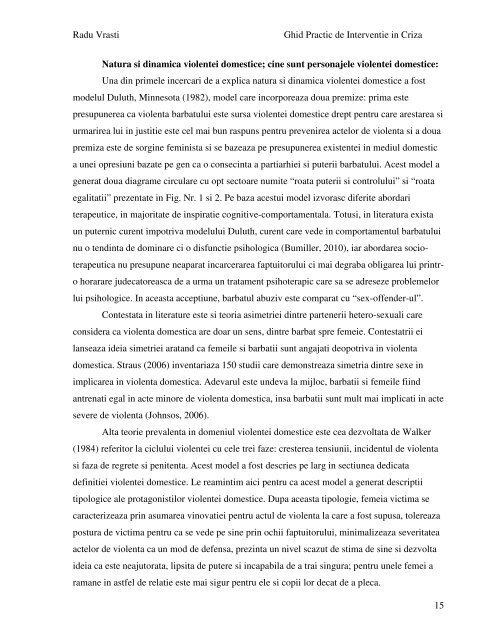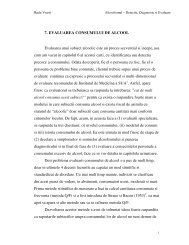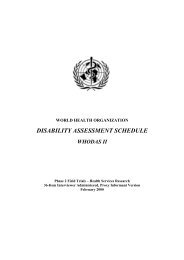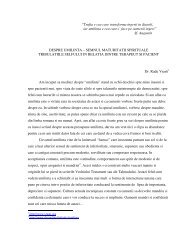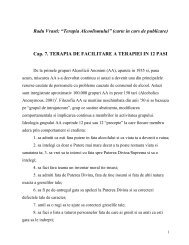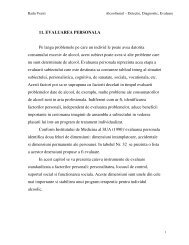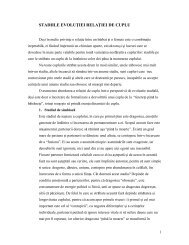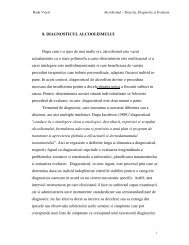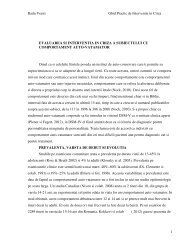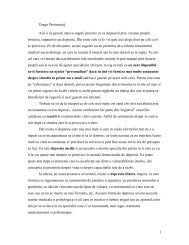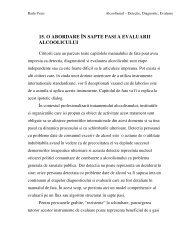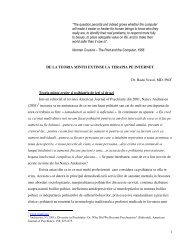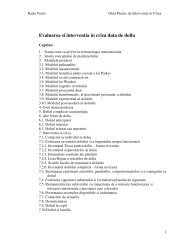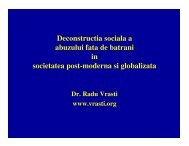Evaluarea si interventia in criza data de violenta - Dr. Radu Vrasti ...
Evaluarea si interventia in criza data de violenta - Dr. Radu Vrasti ...
Evaluarea si interventia in criza data de violenta - Dr. Radu Vrasti ...
Create successful ePaper yourself
Turn your PDF publications into a flip-book with our unique Google optimized e-Paper software.
<strong>Radu</strong> <strong>Vrasti</strong> Ghid Practic <strong>de</strong> Interventie <strong>in</strong> Criza<br />
Natura <strong>si</strong> d<strong>in</strong>amica violentei domestice; c<strong>in</strong>e sunt personajele violentei domestice:<br />
Una d<strong>in</strong> primele <strong>in</strong>cercari <strong>de</strong> a explica natura <strong>si</strong> d<strong>in</strong>amica violentei domestice a fost<br />
mo<strong>de</strong>lul Duluth, M<strong>in</strong>nesota (1982), mo<strong>de</strong>l care <strong>in</strong>corporeaza doua premize: prima este<br />
presupunerea ca <strong>violenta</strong> barbatului este sursa violentei domestice drept pentru care arestarea <strong>si</strong><br />
urmarirea lui <strong>in</strong> justitie este cel mai bun raspuns pentru prevenirea actelor <strong>de</strong> <strong>violenta</strong> <strong>si</strong> a doua<br />
premiza este <strong>de</strong> sorg<strong>in</strong>e fem<strong>in</strong>ista <strong>si</strong> se bazeaza pe presupunerea existentei <strong>in</strong> mediul domestic<br />
a unei opre<strong>si</strong>uni bazate pe gen ca o consec<strong>in</strong>ta a partiarhiei <strong>si</strong> puterii barbatului. Acest mo<strong>de</strong>l a<br />
generat doua diagrame circulare cu opt sectoare numite “roata puterii <strong>si</strong> controlului” <strong>si</strong> “roata<br />
egalitatii” prezentate <strong>in</strong> Fig. Nr. 1 <strong>si</strong> 2. Pe baza acestui mo<strong>de</strong>l izvorasc diferite abordari<br />
terapeutice, <strong>in</strong> majoritate <strong>de</strong> <strong>in</strong>spiratie cognitive-comportamentala. Totu<strong>si</strong>, <strong>in</strong> literatura exista<br />
un puternic curent impotriva mo<strong>de</strong>lului Duluth, curent care ve<strong>de</strong> <strong>in</strong> comportamentul barbatului<br />
nu o tend<strong>in</strong>ta <strong>de</strong> dom<strong>in</strong>are ci o disfunctie p<strong>si</strong>hologica (Bumiller, 2010), iar abordarea socio-<br />
terapeutica nu presupune neaparat <strong>in</strong>carcerarea faptuitorului ci mai <strong>de</strong>graba obligarea lui pr<strong>in</strong>tr-<br />
o horarare ju<strong>de</strong>catoreasca <strong>de</strong> a urma un tratament p<strong>si</strong>hoterapic care sa se adreseze problemelor<br />
lui p<strong>si</strong>hologice. In aceasta acceptiune, barbatul abuziv este comparat cu “sex-offen<strong>de</strong>r-ul”.<br />
Contestata <strong>in</strong> literature este <strong>si</strong> teoria a<strong>si</strong>metriei d<strong>in</strong>tre partenerii hetero-sexuali care<br />
con<strong>si</strong><strong>de</strong>ra ca <strong>violenta</strong> domestica are doar un sens, d<strong>in</strong>tre barbat spre femeie. Contestatrii ei<br />
lanseaza i<strong>de</strong>ia <strong>si</strong>metriei aratand ca femeile <strong>si</strong> barbatii sunt angajati <strong>de</strong>opotriva <strong>in</strong> <strong>violenta</strong><br />
domestica. Straus (2006) <strong>in</strong>ventariaza 150 studii care <strong>de</strong>monstreaza <strong>si</strong>metria d<strong>in</strong>tre sexe <strong>in</strong><br />
implicarea <strong>in</strong> <strong>violenta</strong> domestica. A<strong>de</strong>varul este un<strong>de</strong>va la mijloc, barbatii <strong>si</strong> femeile fi<strong>in</strong>d<br />
antrenati egal <strong>in</strong> acte m<strong>in</strong>ore <strong>de</strong> <strong>violenta</strong> domestica, <strong>in</strong>sa barbatii sunt mult mai implicati <strong>in</strong> acte<br />
severe <strong>de</strong> <strong>violenta</strong> (Johnsos, 2006).<br />
Alta teorie prevalenta <strong>in</strong> domeniul violentei domestice este cea <strong>de</strong>zvoltata <strong>de</strong> Walker<br />
(1984) referitor la ciclului violentei cu cele trei faze: cresterea ten<strong>si</strong>unii, <strong>in</strong>ci<strong>de</strong>ntul <strong>de</strong> <strong>violenta</strong><br />
<strong>si</strong> faza <strong>de</strong> regrete <strong>si</strong> penitenta. Acest mo<strong>de</strong>l a fost <strong>de</strong>scries pe larg <strong>in</strong> sectiunea <strong>de</strong>dicata<br />
<strong>de</strong>f<strong>in</strong>itiei violentei domestice. Le ream<strong>in</strong>tim aici pentru ca acest mo<strong>de</strong>l a generat <strong>de</strong>scriptii<br />
tipologice ale protagonistilor violentei domestice. Dupa aceasta tipologie, femeia victima se<br />
caracterizeaza pr<strong>in</strong> asumarea v<strong>in</strong>ovatiei pentru actul <strong>de</strong> <strong>violenta</strong> la care a fost supusa, tolereaza<br />
postura <strong>de</strong> victima pentru ca se ve<strong>de</strong> pe <strong>si</strong>ne pr<strong>in</strong> ochii faptuitorului, m<strong>in</strong>imalizeaza severitatea<br />
actelor <strong>de</strong> <strong>violenta</strong> ca un mod <strong>de</strong> <strong>de</strong>fensa, prez<strong>in</strong>ta un nivel scazut <strong>de</strong> stima <strong>de</strong> <strong>si</strong>ne <strong>si</strong> <strong>de</strong>zvolta<br />
i<strong>de</strong>ia ca este neajutorata, lip<strong>si</strong>ta <strong>de</strong> putere <strong>si</strong> <strong>in</strong>capabila <strong>de</strong> a trai <strong>si</strong>ngura; pentru unele femei a<br />
ramane <strong>in</strong> astfel <strong>de</strong> relatie este mai <strong>si</strong>gur pentru ele <strong>si</strong> copii lor <strong>de</strong>cat <strong>de</strong> a pleca.<br />
15


